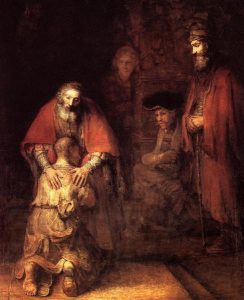Rembrandt, The Return of the Prodigal Son
The Calvinist injunction against religious art did not prevent Rembrandt from making a series of religious paintings and prints. Rembrandt had a special interest in probing the states of the human soul. The spiritual stillness of his later religious paintings is that of inward-turning contemplation.

The Dutch artist’s psychological insight and his profound sympathy for human affliction produced, at the end of this life, one of the most moving pictures in the history of biblical art, Return of the Prodigal Son. In this New Testament parable, the younger of two sons leaves his home and squanders his wealth on a life of sin. When he becomes poor and hungry and sees the error of his ways, he returns home. In Rembrandt’s painting, the forgiving father tenderly embraces his lost son, who crouches before him in weeping contrition, while three figures, immersed to varying degrees in the soft shadows, note the lesson of mercy. The light, everywhere mingled with shadow, directs the viewer’s attention by illuminating the father and son and largely veiling the witnesses. Its focus is the beautiful, spiritual face of the old man. Secondarily, the light touches the contrasting stern face of the foremost witness. The painting demonstrates the degree to which Rembrandt developed a personal style completely in tune withe the simple eloquence of the biblical passage.[1]
- Fred S. Kleiner, Gardner's Art Through the Ages: The Western Perspective, vol. II, 15th ed. (Boston: Cengage, 2017), 623. ↵

